No. 73 – October 24, 2004 |
Other articles on similar
subjects
are published in English
in the
Offline
column
|
 |
1.
Faster growth? |
|
|
The growth of the internet was never “slow” –
but in 200-2001 it wasn’t as fast as in previous years. Now
there seems to be a change. Of course data and statistics are never
totally accurate, and trends need to be understood over extended
periods of time, but figures for year 2003 and the first half of 2004
show increasing acceleration.
Wordlwide hostcount seems likely to exceed 300 million this year.
Growh in June 2004 was 76 percent compared to two years earlier. Europe
had over 30 million internet hosts in 2003, over 40 in June 2004 and, if
this trend continues, will be above 50 million by year end.
A more detailed analysis is in the data
section. Summaries of the situation in past years were reported in this
newsletter since 1997 – recently in issues 62
(February 2002) 68 (April 2003)
70 (February 2004) and this will remain
as a “historical record” when a new update will be available,
probably in the first quarter of 2005.
In this issue, in addition to wordwide and European data, there are
summaries of the situation in Latin America, Asia and Africa.
back to top
|
 |
2. New worldwide data |
|
|
The analysis of international data
confirms strong growth of the internet worldwide. This is the evolution
from 1994 to 2004.
| |
Number
of hosts |
annual
growth |
| 1994 |
5,800,000 |
+ 119 % |
| 1995 |
12,900,000 |
+ 104 % |
| 1996 |
21,800,000 |
+ 104 % |
| 1997 |
28,700,000 |
+ 52 % |
| 1998 |
42,200,000 |
+ 46 % |
| 1999 |
72,400,000 |
+ 68 % |
| 2000 |
109,600,000 |
+ 51 % |
| 2001 |
147,300,000 |
+ 35 % |
| 2002 |
171,600,000 |
+ 17 % |
| 2003 |
233,100,000 |
+ 26 % |
| 2004 |
285,139,107 |
+ 41 % |
There seems to be a new acceleration after a (relatively) slower
phase in 2001-2002, but we shall need to look at figures fo following
periods to understand how the trend is evolving.
The broad picture by “large geographic areas”
hasn’t basically changed.
Large
geographic areas
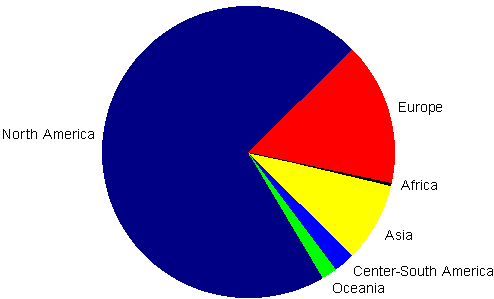
In the last two years growth in central-south America, Asia and Europe
was faster than the world average. The percentage of North America is
constantly (though slowly) decreasing, but it still has a dominant
share, mostly because of internet concentration in the United States.
In 1999 there were six countries worldwide with over a million
internet hosts (two in Europe). In 2000 there were ten (four in Europe).
In 2001 thirteen (six in Europe). Seventeen (nine in Europe) in 2002
and twenty in 2003. Now there are twentyone – fourteen in Europe,
four in the Americas, two in Asia and one in Oceania.
The countries with over three million hosts were two in 2001, eight
in 2003 and there are eleven in 2004. Seven countries (five in Europe)
now have over four million.
Some data are questionable – as in the case of Italy (traditionally
much weaker) now being far ahead of the UK and Germany. But the
broad picture is fairly coherent and consistent over time.
This chart shows data for 34 countries (of 240) with over 300,000
internet hosts.
| |
Number of hosts
June 2004 |
% growth
in two years |
% of
total |
Per 1000
inhabit. |
| United States |
176,900,000 |
+ 67.7 |
62.0 |
630.1 |
| Japan |
16,445,223 |
+ 88.7 |
5.7 |
129.6 |
| Italy |
7,447,300 |
+ 151.7 |
2.6 |
132.3 |
| Netherlands |
5,278,792 |
+ 100.5 |
1.9 |
332.8 |
| Germany |
4,892,860 |
+ 67.4 |
1.7 |
57.0 |
| United Kingdom |
4,173,453 |
+ 66.4 |
1.5 |
69.8 |
| France |
4,085,340 |
+ 99.0 |
1.4 |
69.8 |
| Australia |
3,939,321 |
+ 57.8 |
1.4 |
232.1 |
| Canada |
3,562,482 |
+ 13.8 |
1.3 |
118.8 |
| Brazil |
3,485,773 |
+ 75.3 |
1.2 |
20.5 |
| Taiwan |
3,153,004 |
+ 73.8 |
1.1 |
149.7 |
| Spain |
2,300,000 |
+ 35.7 |
0.8 |
56.1 |
| Poland |
1,993,016 |
+ 164.3 |
0.7 |
51.6 |
| Sweden |
1,871,294 |
+ 57.5 |
0.7 |
210.7 |
| Belgium |
1,773,603 |
+ 113.0 |
0.6 |
173.2 |
| Denmark |
1,722,081 |
+ 97.4 |
0.6 |
321.9 |
| Finland |
1,532,763 |
+ 25.8 |
0.5 |
295.1 |
| Mexico |
1,523,277 |
+ 51.6 |
0.5 |
15.6 |
| Switzerland |
1,505,058 |
+ 125.5 |
0.5 |
206.6 |
| Norway |
1,367,973 |
+ 115.7 |
0.5 |
302.7 |
| Austria |
1,284,933 |
+ 78.3 |
0.5 |
159.3 |
| Argentina |
926,667 |
+ 90.6 |
0.3 |
25.7 |
| Russia |
874,500 |
+ 9.2 |
0.3 |
6.0 |
| Hong Kong |
783,371 |
+ 102.1 |
0.3 |
116.8 |
| Israel |
754,244 |
+ 224.7 |
0.3 |
128.5 |
| South Korea |
600,000 |
n.a. |
0.2 |
13.5 |
| New Zealand |
587,678 |
+ 40.1 |
0.2 |
157.3 |
| Singapore |
503,099 |
+ 48.0 |
0.2 |
154.2 |
| Hungary |
491,839 |
+ 115.4 |
0.2 |
48.2 |
| Turkey |
474,129 |
+ 187.0 |
0.2 |
7.5 |
| Czech Republic |
443,299 |
+ 22.4 |
0.2 |
43.1 |
| Portugal |
419,402 |
+ 57.5 |
0.2 |
40.5 |
| Thailand |
360,255 |
+ 302.3 |
0.1 |
5.9 |
| South Africa |
350,501 |
+ 42.1 |
0.1 |
8.1 |
| World |
285,139,107 |
+ 75.8 |
|
18.6 |
This graph shows the situation, in the first half of 2004, for
the eleven countries with over three million internet hosts.
Internet
hosts in 11 countries
countries worldwide with
over three million hosts
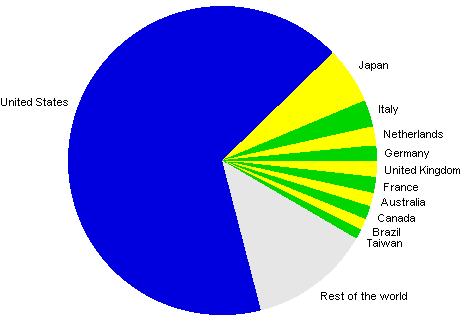
If, for better readability of the chart, we exclude the United States, this
is the pictire for the other twenty countries with over a million hosts.
Internet hosts in
20 countries
countries
worldiwide with over a million hosts (US
excluded)
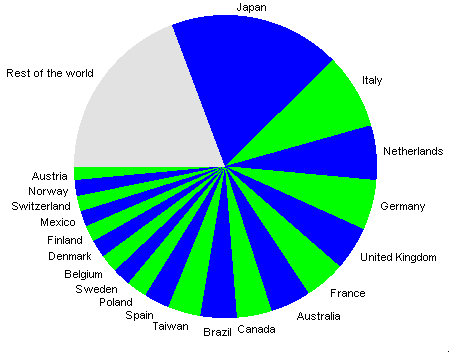
This is an update of the graph showing density (hosts per 1000 inhabitants)
for the 27 countries (excluding the US) with over 500,000 internet hosts.
Internet hosts
per 1000 inhabitants in 27 countries
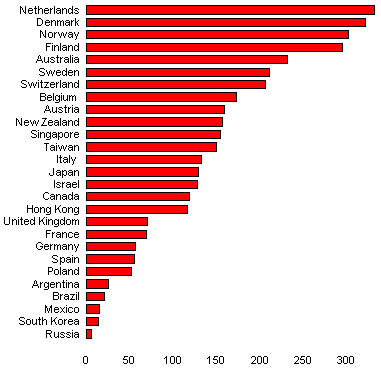
And, as usual, this is the density picture shown as a map.
Internet hosts
per 1000 inhabitants
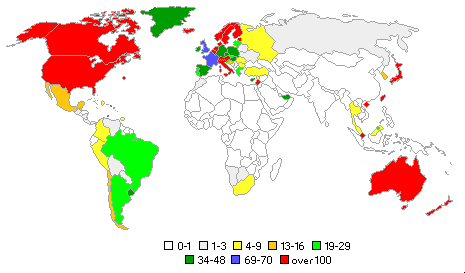
More detailed data and comments, including a graph of hostcount in relation
to income, are in the international data analysis.
back to top
|
 |
3.
New European data |
|
|
There are some relevant changes in Europe compared to the
situation that was summarized in
issue 70 (February 2004.) As
usual, a more detailed analsis, with comments, is in the basic document
on European data.
Now the total in Europe is over 44 million internet hosts. This
is an update for the 25 European countries with 100,000.
| |
Number of hosts
June 2004 |
% of
Europe |
Per 1000
inhabit |
| Italy |
7,447,300 |
16.8 |
132.3 |
| Netherlands |
5,278,792 |
11.9 |
332.8 |
| Germany |
4,892,860 |
11.0 |
57.0 |
| United Kingdom |
4,173,453 |
9.4 |
69.8 |
| France |
4,085,340 |
9.2 |
69.8 |
| Spain |
2,300,000 |
5.2 |
56.1 |
| Poland |
1,993,016 |
4.3 |
51.6 |
| Sweden |
1,871,294 |
4.2 |
210.7 |
| Belgium |
1,773,603 |
4.0 |
173.2 |
| Denmark |
1,722,081 |
3.9 |
321.9 |
| Finland |
1,532,763 |
3.5 |
295.1 |
| Switzerland |
1,505,058 |
3.4 |
206.6 |
| Norway |
1,367,973 |
3.1 |
302.7 |
| Austria |
1,284,933 |
2.9 |
159.3 |
| Russia |
874,500 |
2.0 |
6.0 |
| Hungary |
491,839 |
1.1 |
48.2 |
| Czech Republic |
443,299 |
1.0 |
43.1 |
Portugal |
419,402 |
0.9 |
40.5 |
| Greece |
294,670 |
0.66 |
28.7 |
| Romania |
220,242 |
0.50 |
9.8 |
| Estonia |
201,684 |
0.45 |
147.6 |
| Ireland |
163,346 |
0.38 |
45.1 |
| Ukraine |
130,569 |
0.29 |
2.6 |
| Slovakia |
128,002 |
0.29 |
23.9 |
| Iceland |
126,368 |
0.28 |
453.4 |
| European Union |
39,981,400 |
90.1 |
89.3 |
| Europe |
44,392,800 |
|
63,2 |
In addition to the continuing (and surprising) growth of Italy
and further development in the Netherlands, rencent changes include
an acceleration in France and a strong increase in Poland.
This graph shows the situation, in the first half of 2004, in the 15
European countries with over 500,000 internet hosts.
Internet
hosts in 15 European countries
countries with over 500,000
hosts
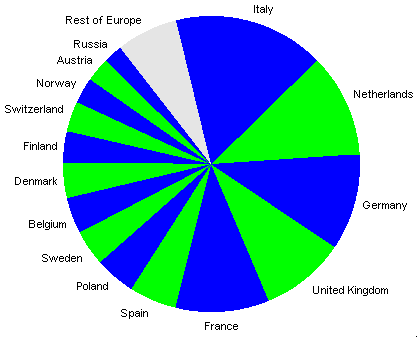
This is an update of the graph showing density (hosts per 1000
inhabitants) in the 25 European countries with over 100,000 internet
hosts.
Internet hosts per 1000
ihabitants
in 25 European countries
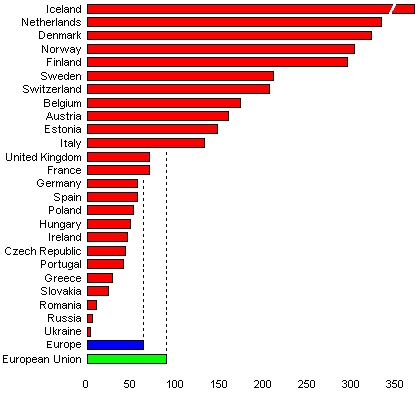
And this is the density picture as a map of Europe.
Internet hosts per 1000
inhabitants
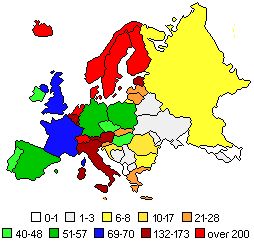
There is considerable growth almost everywhere in Europe, but there
are still great differences in an always changing and evolving situation.
back to top
|
 |
4.
Latin America, Asia and Africa |
|
|
In the data section there is an analysis of
large language communities
that includes a description of internet development in Latin America.
This table shows the situation in the 16 Latin American countries
with over 5,000 internet hosts.
| |
Number of hosts
June 2004 |
Per 1000
inhabit. |
| Brazil |
3,458,773 |
20.5 |
| Mexico |
1,523,277 |
15.6 |
| Argentina |
926,667 |
25.7 |
| Chile |
212,250 |
14.2 |
| Colombia |
184,751 |
4.6 |
| Peru |
110,118 |
4.2 |
| Uruguay |
108,188 |
34.2 |
| Dominican Rep. |
65,494 |
7.7 |
| Venezuela |
38,025 |
1.6 |
| Guatemala |
23,743 |
2.1 |
| Costa Rica |
11,194 |
2.9 |
| Nicaragua |
10,009 |
1.9 |
| Panama |
9,626 |
3.4 |
| Paraguay |
9,243 |
1.8 |
| Ecuador |
8,800 |
0.7 |
| Bolivia |
8,346 |
1.0 |
| Latin America |
6,734,400 |
13.9 |
This graph shows density (internet hosts per thousand inhabitants.)
Internet
hosts per 1000 inhabitants
in 16 Latin American
countries
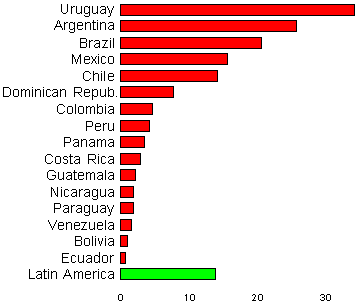
And this is density in Latin America seen as a map.
Internet hosts
per 1000
inhabitants
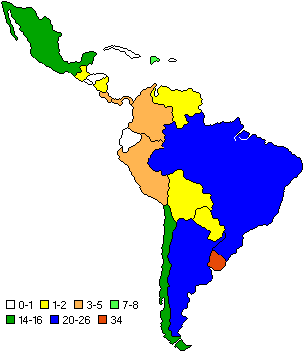
Simple arithmetic indicates that by now Argentina has probably become
the third Latin American country with over a million internet hosts. There
is relevant growth in several other countries. A more detailed analysis
(including a graph in relation to income) is in the report on
large language communities.
Here is a summary of a new report in the data section that covers the
situation in Asia. This table includes
the 19 countries (of 50 in Asia) with over 10,000 internet
hosts.
| |
Number of hosts
June 2004 |
% growth
in two years |
Per 1000
inhabit. |
| Japan |
16,445,223 |
+ 88.7 |
129.6 |
| Taiwan |
3,153,004 |
+ 73.8 |
149.7 |
| Hong Kong |
783,371 |
+ 102.1 |
116.8 |
| Israel |
754,244 |
+ 224.7 |
128.5 |
| South Korea |
600,000 |
n.a. |
13.5 |
| Singapore |
503,099 |
+ 48.0 |
154.2 |
| Turkey |
474,129 |
+ 187.0 |
7.5 |
| Thailand |
360,255 |
+ 302.3 |
5.9 |
| China |
162,421 |
+ 79.8 |
0.13 |
| India |
143,654 |
+ 73.1 |
0.14 |
| Malaysia |
135,082 |
+ 70.0 |
5.8 |
| Indonesia |
111,630 |
+ 111.2 |
0.5 |
| Arab Emirates |
107,966 |
+ 32.6 |
36.7 |
| Philippines |
65,390 |
+ 117.7 |
0.86 |
| Cyprus |
27,966 |
+ 94.1 |
40.6 |
| Pakistan |
25,079 |
+ 73.3 |
0.19 |
| Saudi Arabia |
17,838 |
+ 78.0 |
0.86 |
| Kazakhstan |
12,526 |
+ 60.1 |
0.84 |
| Lebanon |
12,492 |
+ 62.9 |
4.0 |
| Asia |
23,690,000 |
+ 86.3 |
6.3 |
There are dramatic differences in Asia. As shown in this chart of density
(hosts per 1000 inhabitants) in the same 19 countries.
Internet hosts
per 1000 inhabitants
in 19 countries in
Asia
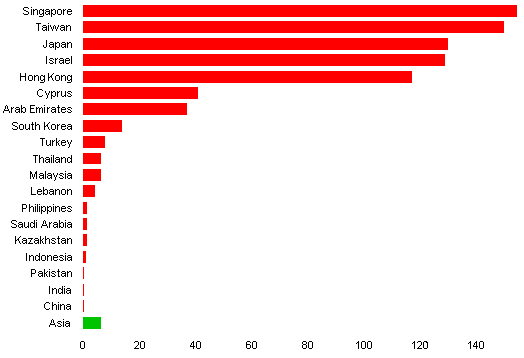
A few small contries, with less than 10,000 hosts, have higher
density of internet activity than most of Asia. The picture can be
summarized in a map that includes the central and southern part of the
continent, from the Middle East to East Asia.
Internet
hosts per 1000
inhabitants

In the report on large language
communities there is an analysis of the Chinese culture countries.
Another document in the data section covers the situation of the
internet in Africa, that was summarized
in issue 72 (August 2004) and here is
updated. This table includes the 13 African countries with over a million
inhabitants and over a thousand internet hosts.
| |
Number of
hosts 2004 |
% growth
in two years |
Per 1000
inhabit. |
| South Africa |
350,501 |
+ 42 |
8.1 |
| Morocco |
71,393 |
n.a. |
2.88 |
| Egypt |
23,407 |
+ 318 |
0.39 |
| Kenya |
10,016 |
+ 354 |
0.33 |
| Zimbabwe |
8,055 |
+ 130 |
0.77 |
Mozambique |
7,167 |
n.a. |
0.41 |
| Tanzania |
5,908 |
+ 200 |
0.17 |
| Namibia |
4,632 |
n.a. |
3.06 |
| Botswana |
2,097 |
+ 65 |
1.23 |
| Zambia |
2,342 |
+ 114 |
0.25 |
| Rwanda |
1,744 |
+ 54 |
0.23 |
| Swaziland |
2,642 |
+ 80 |
2.56 |
| Nigeria |
2,321 |
+ 150 |
0.02 |
| Africa |
497,000 |
+ 76 |
0.61 |
This graph shows density in the same countries (except South Africa.)
Internet hosts
per 1000 inhabitants
in 12 African
countries
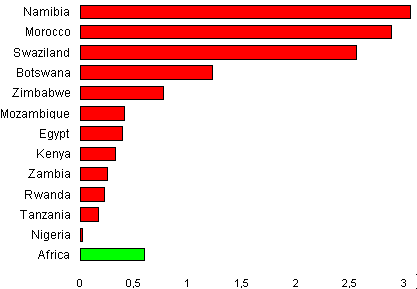
Most of Africa has density comparable to, or lower than, Nigeria. New
data show a higher hostcount on Morocco, that appears to be now the
second largest country in the internet in the continent, though far behind
South Africa.
This is the density picture seen as a map.
Internet hosts per
1000 inhabitants
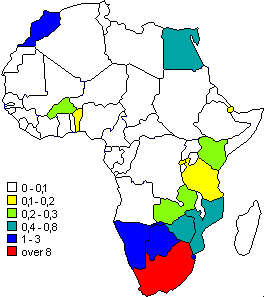
The picture is changing around the world. There are different speeds
of growth, and different density levels, in all areas, from the most
advanced (such as North America and Europe) to the least developed (such as
Africa and a large part of Asia). There is considerable potential for
growth practically everywhere.
|
|